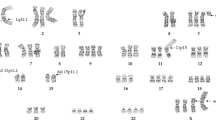Background:
Reliable determination of intrinsic radiosensitivity in individual patients is a serious need in radiation oncology. Chromosomal aberrations are sensitive indicators of a previous exposure to ionizing irradiation. Former molecular cytogenetic studies showed that such aberrations as an equivalent of intrinsic radiosensitivity can be detected by fluoroscence in-situ hybridization (FISH) techniques using whole chromosome painting (wcp) probes. However, only one up to three randomly chosen wcp probes have been applied for such approaches until now. As a random distribution of chromosomal rearrangements along the chromosomes is up to now still controversial, the power of the 24-color FISH approach should be elucidated in the present study.
Methods and Material: Lymphocytes derived from lymphoblastoid cell lines of one patient with Nijmegen breakage syndrome (NBS homozygote) and of two NBS heterozygotes and peripheral blood lymphocytes of two controls were analyzed. Samples of each patient/control were irradiated in vitro with 0.0 Gy, 0.7 Gy or 2.0 Gy prior to cultivation. Chromosomal aberrations were analyzed in detail and quantified by means of 24-color FISH as an expression of the individual intrinsic radiosensitivity.
Results: 24-color FISH analyses were done in a total of 1,674 metaphases. After in-vitro irradiation, 21% (0.7 Gy) or 57% (2.0 Gy) of the controls' cells, 15% (0.7 Gy) or 53% (2.0 Gy) of the heterozygotes' cells and 54% (0.7 Gy) or 79% (2.0 Gy) of the homozygotes' cells contained aberrations. The highest average rates of breaks per mitosis [B/M] (0.7 Gy: 1.80 B/M, 2.0 Gy: 4,03 B/M) and complex chromosomal rearrangements [CCR] (0.7 Gy: 0.20 CCR/M, 2.0 Gy: 0.47 CCR/M) were observed in the NBS patient. Moreover, the proportion of different aberration types after irradiation showed a distinct increase in the rate of CCR combined with a decrease in dicentrics in the NBS homozygote.
Conclusion: To come to a more complete picture of radiation-induced aberrations and to detect and quantify genetically determined intrinsic radiosensitivity, a 24-color FISH approach using all human chromosome painting probes has been successfully applied on cytogenic preparation lymphocytes. The controls and NBS heterozygotes were clearly distinguished from the NBS homozygote subject.
Hintergrund:
Die Verfügbarkeit eines verlässlichen und schnellen prädiktiven Testsystems zur Bestimmung individueller Radiosensitivität von Tumorpatienten ist in der onkologischen Strahlentherapie von enormer Bedeutung. Molekularzytogenetische Studien haben gezeigt, dass intrinsische Radiosensitivität in Form von chromosomalen Aberrationen mittels Fluoreszenz-in-situ-Hybridisierungs-(FISH-)Techniken unter Verwendung von sog. “whole chromosome painting”-(wcp-)Sonden nachgewiesen werden kann. Bisher wurden für solche Ansätze allerdings lediglich maximal drei zufällig ausgewählte wcp-Sonden gleichzeitig eingesetzt. Da eine zufällige Verteilung der induzierten Schäden über das Genom bisher immer noch ungeklärt ist, sollten die Grenzen und Möglichkeiten der 24-Farben-FISH-Methode für die Bestimmung individueller Strahlenempfindlichkeit mit der vorliegenden Studie ermittelt werden.
Methoden und Material: Lymphozyten aus lymphoblastoiden Zelllinien von einem Patienten mit Nijmegen-Breakage-Syndrom (NBS-homozygoter Genträger) und von zwei NBS-heterozygoten Genträgern sowie Lymphozyten aus peripheren Blut von zwei Kontrollen wurden untersucht. Die Proben wurden in vitro mit 0,0 Gy, 0,7 Gy oder 2,0 Gy bestrahlt und anschließend kultiviert. Die chromosomalen Aberrationen wurden mittels 24-Farben-FISH analysiert und können als Maß für die individuelle intrinsische Strahlenempfindlichkeit interpretiert werden.
Ergebnisse: Mittels der 24-Farben-FISH Methode wurden insgesamt 1674 Metaphaseplatten analysiert. Nach In-vitro-Bestrahlung mit 0,7 bzw. 2,0 Gy zeigten 21% bzw. 57% der Zellen der beiden Kontrollen, 15% bzw. 53% der Zellen der beiden NBS-Heterozygoten und 54% bzw. 79% der Zellen des NBS-Homozygoten Aberrationen. Die höchsten durchschnittlichen Bruchraten (Brüche pro Mitose = B/M) (0,7 Gy: 1,80B/M, 2,0 Gy: 4,03 B/M) und Raten an komplexen chromosomalen Rearrangements (= CCR) (0,7 Gy: 0,20 CCR/M, 2,0 Gy: 0,47 CCR/M) wurden in den Zellen des NBS-homozygoten Patienten nachgewiesen. Nach Bestrahlung zeigte sich ein deutlicher Anstieg bezüglich der Anzahl an CCR bei einem gleichzeitigen Abfall der Anzal an dizentrischen Chromosomen beim NBS-Homozygoten.
Schlussfolgerung: Die Methoden der 24-Farben-FIS unter Verwendung aller menschlischen wcp-Sonden wurde erfolgreich zu Nachweis, Charakterisierung und Quantifizierung strahleninduzierter chromosomaler Aberrationen in Lymphozyten eingesetzt. Darüber hinaus ist diese Methode geeignet, um ein vollständigeres Bild der entstandenen chromosomalen Rearrangements zu erhalten. Kontrollen und NBS-Heterozygote konnten klar von einem NBS-homozytogen Genträger unterschieden werden.
Similar content being viewed by others
Author information
Authors and Affiliations
Additional information
Received: June 29, 2001; accepted: January 22, 2002
Rights and permissions
About this article
Cite this article
Kuechler, A., Neubauer, S., Grabenbauer, G. et al. Is 24-Color FISH Detection of In-Vitro Radiation-Induced Chromosomal Aberrations Suited to Determine Individual Intrinsic Radiosensitivity?. Strahlenther Onkol 178, 209–215 (2002). https://doi.org/10.1007/s00066-002-0904-0
Issue Date:
DOI: https://doi.org/10.1007/s00066-002-0904-0




